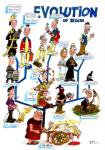
I wanted to cover this story for a couple of reasons, and one of them is the use of common language to describe a scientific concept. I love the term "Sleeping Beauty" in relationship to scientists finding genes that have a cancer connection.
The finding really is significant, and reported in the science journal
Nature.
Researchers have discovered a new method that could accelerate the way cancer-causing genes are found and lead to a more accurate identification of the genes.
The gene identification method uses a piece of jumping DNA, called Sleeping Beauty.
Jumping genes, or transposons, insert themselves into or between genes and can activate or inactivate a gene’s normal function.
Now stick with me to follow how it came to be called Sleeping Beauty, as it is intriguing.
The scientists say, in an
NIH press release, that related transposons are natural to the genetic makeup of humans, animals and fish, but through millions of years of evolution, most transposons became inactive dead-ends.
A few years back researchers took defunct jumping genes from fish and made the genes jump again. This research had reactivated the element in jumping genes from millions of years of evolutionary sleep, and thus the name Sleeping Beauty, the NIH states.
Researcher David Largaespada says, “Current cancer gene identification methods, such as microarrays, give correlations typically of thousands of genes, and it’s hard to know from the correlations which genes relate to cancer and which do not. By comparison, the jumping gene has attached itself to cancer genes in the tumors we studied and thereby allows us to focus in on smaller numbers of genes - genes that we know are important to the genesis of tumors. The result is a quicker, more efficient, and accurate identification of cancer-causing genes.”
Says Largaespada, “About 300 human cancer-related genes have thus far been reported in the scientific literature. There may be as many as 1,000 or more cancer genes that still need to be identified.”
Researcher Nancy Jenkins says, "The outcome of the new Sleeping Beauty method could be a major leap forward in understanding cancer’s weak points and subsequently lead to thousands more cancer patients joining the ranks of survivors.”
 I love words. An easy way to learn a new word each day is to sign up for Word of the Day on Google's new personalized home page. Here are some words from the past week. It would be great to hear these words used more often in our day-to-day speech, or at least see them in an email or two:
I love words. An easy way to learn a new word each day is to sign up for Word of the Day on Google's new personalized home page. Here are some words from the past week. It would be great to hear these words used more often in our day-to-day speech, or at least see them in an email or two:








































 Explorations of "ice oceans" and discovering never-before-seen life - I just had to look closer at this story released this afternoon - even though I am off on a science tangent not all that related to medical discovery.
Explorations of "ice oceans" and discovering never-before-seen life - I just had to look closer at this story released this afternoon - even though I am off on a science tangent not all that related to medical discovery.







